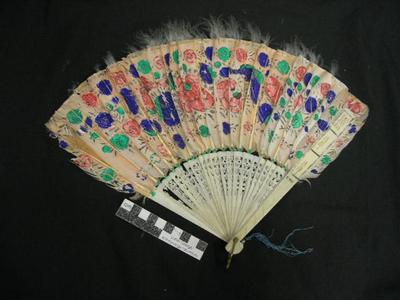E0403: Fan
Ethnographic
Identifier:
E0403Classification Category:
3:Personal Artifacts ➞ Personal GearMaterials:
animal ➔ featheranimal ➔ bone
metal
colorant ➔ paint
Dimensions:
28 cm L45.5 cm W
2 cm H
Provenance of Object:
This fan is of Chinese style due to numerous aspects of the fan. However it is possible that it is Korean as well. It is very possible that Korea adopted the style of Chinese work during the late 1800’s because of the large influence that China had in Korea during this time. Although because of the fan painting motif, and ivory inscriptions I would argue that it is Chinese style.A fan of this type was common amongst the upper class Manchu Women of the Mid-Qing dynasty. This can be determined by examining pictures of these women, recognizable by their hairstyle. Often these women were seen holding a fan similar to this one as an accessory. (Hist361)
This object was held in the museum that Luther College started in 1877. This museum eventually grew into the Vesterheim Norwegian-American Museum, and following this, non-Norwegian American ethnographic objects were returned to Luther and accessioned into the college’s Anthropology Collection. Without additional documentation, was likely obtained by the Luther College Museum (later the Norwegian-American Museum) between the late 19th century and early 20th century.

